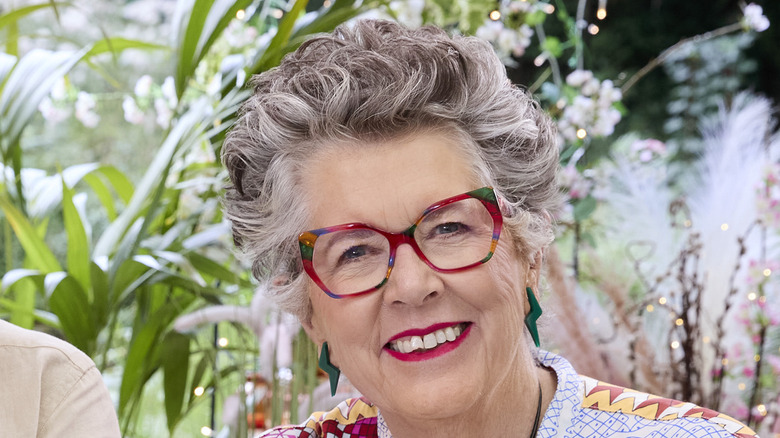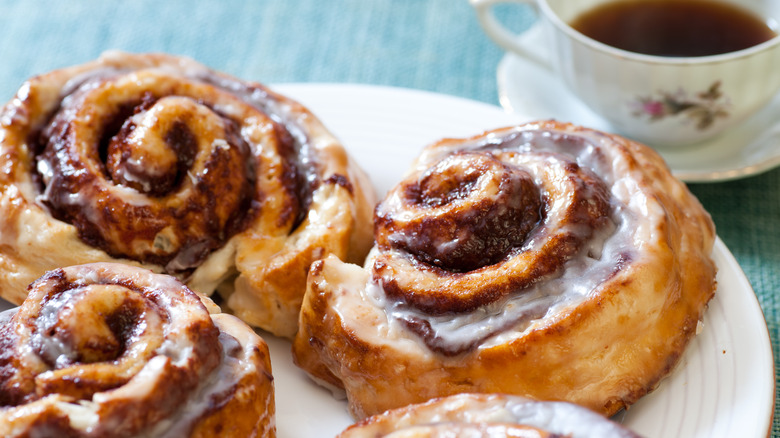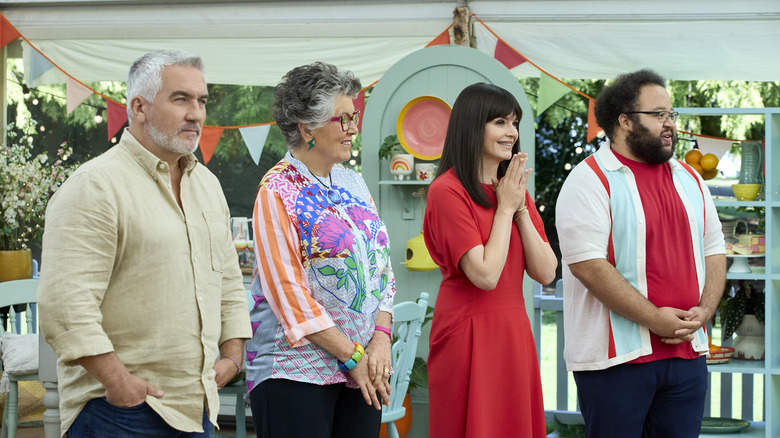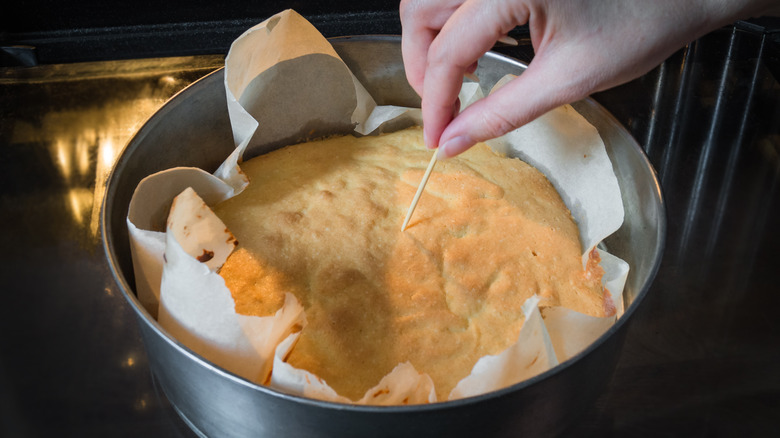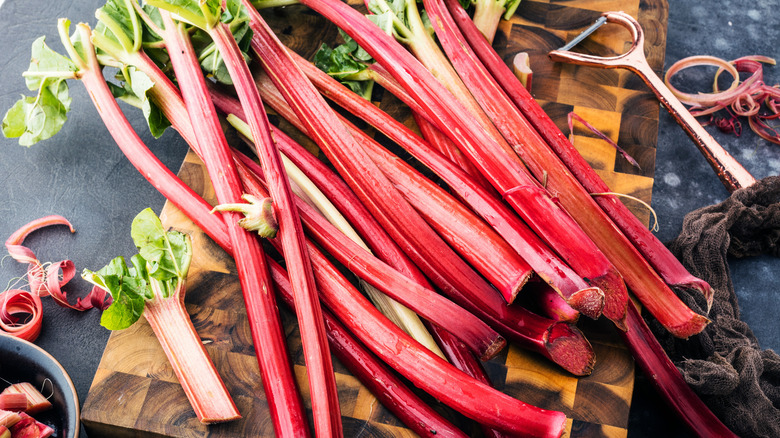Prue Leith Says This Is The Real Difference Between British And American Bakers - Exclusive Interview
On your mark, get set, bake! Another season of "The Great American Baking Show" is hitting TV screens on Friday, May 24th, and our mouths are already watering. Available exclusively on The Roku Channel, this season brings host Zach Cherry, new host Casey Wilson, and iconic and irreplaceable judges Prue Leith and Paul Hollywood together with eight new American bakers, all whisking their way toward the title of America's Best Amateur Baker.
As we count down to the first signature challenge, we had a chance to chat with the ever-colorful Dame Prue Leith about what viewers can expect from American bakers this season. Leith gave us insight into the differences — and similarities — between American bakers and their British counterparts. She also shared a few tips for home bakers — must-knows, whether you're cooking for friends or hoping to earn a spot on a future season of "The Great American Baking Show."
What sets American and British bakers apart
America is such a diverse country. Did this season's group of bakers bring something to the competition that you have not seen before?
I wish Paul Hollywood was here to answer this question because he answers it beautifully ... The reason he's been giving out more handshakes than he ever has before is that the standard of American baking has just leapt up in the last couple of years. Neither of us know whether this is a nationwide phenomenon. It could be because COVID had people at home baking more than they had before ... We've seen a rise in both "The Great British Bake Off" and "The Great American Baking Show" ... I think it's absolutely true that there has been a big jump and it's much, much better.
Have you noticed any differences in technique or style between the American contestants and British contestants from other seasons?
The skills are the same. Baking is baking and if you need to laminate a pastry, it doesn't matter what country you come from. Basically, you have to get butter into it and roll it and fold it, and the techniques may vary slightly about how you roll it and fold it, but very little. The same techniques are necessary in baking wherever you are. And so, no, I don't think that they're very different.
I think there's a difference in taste levels. Americans tend to like things a bit sweeter than Brits do. And also you like a bit more frosting on it, which is again, more sugar. But you put enormous thick frosting on, which we don't like quite so much. Mind you, I like a bit of cream cheese frosting, and you are very good at cream cheese frosting.
I love the fact that you can get a good cinnamon roll anywhere in America. You are very good at cinnamon, and again, probably a bit too much sugar, but lots of cinnamon, which I love.
A language barrier that drove Paul Hollywood mad
Americans love to talk about how calm and even stoic the British contestants are, even under all the pressure in the tent. Did you notice a different vibe in the tent with American contestants?
Americans perhaps express their ... They're a little bit more open about their emotions. Maybe the British are a little bit more po-faced and with a stiff upper lip ... But you get to know them so well and after a few weeks they all relax and become much more themselves. And then even the British will show you that they're worried or stressed more than they would normally. But ... I think the Americans are just as good at holding down stress because they know that the only way to get through is to stay calm, not panic.
And you know what, we've got probably the best eight bakers in the country and there are 300 million people in the country. I think that's the thing to remember, that every single show has bakers in it that are all capable of winning. Probably the last 200 people in the audition process could all win "Bake Off."
But what sorts them out is that we're testing them all the time on their baking skills. When they get into the tent, there's suddenly something else in there, which is how you cope with a strange environment, with cameras all over the place, with the general stress of knowing that you're actually in the "Bake Off" tent. That maybe makes more of a difference. And the people who tend to get through are the ones who are very organized and very calm.
Were there any language barriers between English and American accents or vocabulary?
I think very occasionally there are, I mean, what I'm always amused about is for some reason it drives Paul Hollywood absolutely mad that we say ... When we set the bakers off, we say "on your marks, get set, go." We say "on your marks" in the plural. You say "on your mark, get set." Do you know what? I don't think it matters.
But Paul — "They say on your mark!" I told him, "In America they say mark," and he says, "But there's more than one mark. If you put on a race, there are lots of marks." I said, "No, this might be one line and it's one mark." A ridiculous argument, always with me defending the Americans, but there are little things like that. We say icing, you say frosting. But we all understand each other's language, in spite of [being] two nations separated by a common language.
Prue's tips for a moist, flavorful cake
The first week in the new season is cake week, and you mentioned flavor being what really distinguishes a great cake from a boring one. Do you have some tips for home bakers who are looking to really amp up the flavor in their cakes?
Well, there are lots of ways to amp up flavor. The most obvious one is, if you made a good sponge, if you give it a punchy filling like lemon curd or chocolate spread or something which will hit your taste buds, that is the easiest way to do it. But there are other ways that I think are quite lovely.
I make a really nice sesame seed cake, which has a cup full of black sesame seeds in it and a bit of sesame oil, and that makes it absolutely delicious, even though there's no icing and there's no filling.
I think we tend to rely too much on the sugary things for flavor like icing and filling. Sometimes flavor can go into the cake. Think of lemon zest and a bit of lemon syrup in a lemon drizzle cake. Lemon and orange rind and all these flavors that just enhance the crumb are more interesting, I think, than just having a plain sponge with pretty well no flavor and relying on the icing and the topping.
What about ways to keep that sponge nice and moist? Do you like to use syrups to add moisture and flavor?
If you've overbaked your cakes, the best thing to do is to make a syrup and drizzle it on because that'll help. But the main thing is not to overbake it.
With a sponge cake, the absolutely infallible test when the cake is done is to stick a cocktail stick or a skewer into the middle and pull it out. And if there's still liquidy goo stuck to the stick, then you need to give it another five minutes or so. But the minute it comes out clean, take it out. Leave it in even five minutes longer and it might be a bit dry. And it's such a pity to have a cake that looks perfect, it's risen beautifully, but it's dry. Get them out when they're done. But not with that soggy middle.
Must-know kitchen hacks from Prue Leith
You've been sharing some really great cooking hacks on your Instagram recently. Do you have any other go-to cooking and baking tricks that you rely on?
Well, one of the ones that I did — I put it on Instagram years ago, and it was the most popular one I've ever done — was such a simple thing that I can't believe the whole world doesn't do it. If you have brown sugar and you leave the packet open for a bit or for some reason or other, the brown sugar goes rock solid, like a brick, you just don't know how to, you end up trying to bash it apart. All you need to do is to put a lemon or a marshmallow into the jar with it and close it up, and the next day it'll be slightly softened, and in three days it'll be completely soft. It just absorbs enough moisture to completely soften it. I put a picture of a Kilner jar with like a — you would call it a mason jar — a mason jar with a lemon on the top of the sugar. And that had millions of likes because people were so thrilled. It's such a simple thing.
And then there's a very interesting, and I think wonderful, thing it took me years to learn. I always struggled with cooking rhubarb, because when you cut rhubarb into chunks, put a little bit of sugar on it and put it in the oven or put it in a frying pan or whatever it is, with a tiny bit of orange juice or something, within seconds it's all shreds and it's overcooked. So you want to keep the pieces of rhubarb whole, and I've now realized that it's so simple ... You put the little chunks of rhubarb into a [heat-safe] plastic bag [in a flat layer], then put the plastic bag in a frying pan full of water and simmer it gently. You can feel through the plastic when it's soft, when it's done, and they all turn out perfectly. So nice and pink and looking lovely.
Season two of "The Great American Baking Show" premiers on Friday, May 24th exclusively on The Roku Channel.
This interview has been edited for clarity.
